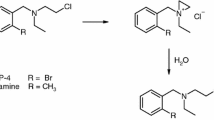Abstract
The turning behaviour induced by 5-methoxy-N,N-dimethyltryptamine (5-MeODMT) has been investigated in rats with lesions of the dorsal raphé nucleus (DRN). 5-MeODMT caused a dose-related contralateral turning in rats with 5,7-dihydroxytrypamine (5,7-DHT) lesions of the substantia nigra and a similar effect was observed in DRN-lesioned rats. In contrast, a dose-related ipsilateral turning was observed when 5-MeODMT was injected into rats with 5,7-DHT lesions of the striatum. These results suggest that the effects of 5-MeODMT in DRN-lesioned rats are mediated via the substantia nigra. The contralateral turning induced by 5-MeODMT in rats with a 5,7-DHT lesion of the DRN was significantly reduced when a second 6-hydroxydopamine lesion was placed in the striatum, but not when it was placed in the nucleus accumbens. Thus the nigrostriatal dopaminergic system seems to be involved in 5-MeODMT-induced turning. The release of tritium from slices of substantia nigra previously labelled with [3H]-dopamine was inhibited by 5-MeODMT (10-7 to 10-5 M) and this effect was blocked by methysergide in a concentration-related manner. Tetrodotoxin (10-7M) failed to antagonise 5-MeODMT. These results suggest that 5-MeODMT can inhibit dopamine release from nigral dendrites, which could in turn enhance nigrostriatal activity by reducing the auto-inhibitory actions of dopamine, thereby causing contralateral turning in DRN-lesioned rats.
Similar content being viewed by others
References
Arbilla S, Kamal LA, Langer SZ (1981) Inhibition by apomorphine of the potassium-evoked release of [3H]-aminobutyric acid from the rat substantia nigra in vitro. Br J Pharmacol 74:389–397
Blackburn TP, Cox B, Heapy CG, Lee TF (1981) Possible mechanisms of 5-methoxy-N,N-dimethyltryptamine-induced turning behaviour in DRN-lesioned rats. Pharmacol Biochem Behav (in press)
Blackburn TP, Cox B, Heapy CG, Lee TF, Middlemiss DN (1981) Supersensitivity on nigral serotonin receptors and rat rotational behaviour. Eur J Pharmacol 71:343–346
Blackburn TP, Foster GA, Heapy CG, Kemp JD (1980a) Unilateral 5,7-dihydroxytryptamine lesions of the dorsal raphé nucleus (DRN) and rat rotational behaviour. Eur J Pharmacol 67:427–438
Blackburn TP, Shore AB, McNab A (1980b) A microcomputer based monitoring system for rat rotational behaviour. Br J Pharmacol 69:347
Dray A, Davis J, Oakley NR, Tongroach P, Vellucci S (1978) The dorsal and medial raphé projections to the substantia nigra in the rat: Electrophysiological, biochemical and behavioural observations. Brain Res 151:431–442
Ennis C, Kemp JD, Cox B (1981) Characterisation of inhibitory 5-hydroxytryptamine receptors that modulate dopamine release in the striatum. J Neurochem 36:1515–1520
Feltner EJ, Meibach RC, Maayani S, Green JP (1981) Radioautographic localisation of [3H]-5-HT and [3H]-d-LSD binding sites on dopaminergic nigral-striatal neurones. Fed Proc 40:265
Fibiger HC, Miller JJ (1977) An anatomical and electrophysiological investigation of the serotonergic projection from the dorsal raphé nucleus to the substantia nigra in the rat. Neurosci 2:975–987
Giambalvo CT, Snodgrass SR (1978) Effect of p-chloramphetamine and 5,7-dihydroxytryptamine on rotation and dopamine turnover. Brain Res 149:453–467
Glick SD, Jerussi TP, Fleischer LN (1976) Turning in cricles: The neuropharmacology of rotation. Life Sci 18:889–896
Glowinski J, Iversen LL (1966) Regional studies of catecholamines in the rat brain—I. J Neurochem 13:655–669
James TA, Starr MS (1980) Rotational behaviour elicited by 5-HT in the rat: Evidence for an inhibitory of 5-HT in the substantia nigra and corpus striatum. J Pharm Tharmacol 32:196–200
König JFR, Klippel RA (1963) The rat brain, a stereotaxic atlas. Williams and Wilkins, Baltimore
Magnusson O, Nilsson LB, Westerland D (1980) Simultaneous determination of dopamine, DOPAC and homovanillic acid. Direct injection of supernatants from brain tissue homogenates in a liquid chromatography-electrochemical detection system. J Chromatogr 221:237–247
Nicolaou NM, Garcia-Munoz M, Arbuthnott GW, Eccleston D (1979) Interactions between serotonergic and dopaminergic systems in rat brain demonstrated by small unilateral lesions of the raphé nuclei. Eur J Pharmacol 57:295–305
Oberlander C, Hunt PF, Dumont C, Boissier JR (1981) Dopamine independent rotational response to unilateral intranigral injection of serotonin. Life Sci 28:2595–2601
Parizek J, Hassler R, Bak IJ (1971) Light and electron microcopic autoradiography of substantia nigra of rat after intraventricular administration of tritium labelled norepinephrine, dopamine, serotonin and the precursors. Z Zellforsch 115:137–148
Pasquier DA, Kemper TL, Forbes WB, Morgane PJ (1977) Dorsal raphé substantia nigra and locus coeruleus: Interconnections with each other and the neostriatum. Brain Res Bull 2:323–339
Pycock CJ (1980) Turning behaviour in animals. Neurosci 5:461–514
Slater P (1980) Circling produced by serotonin and dopamine agonists in raphé lesioned rats: A serotonin model. Pharmacol Biochem Behav 13:817–821
Streit P, Knecht E, Cuenod M (1979) Transmitter-specific retrograde labelling in the striato-nigral and raphé-nigral pathways. Science 205:306–308
Ungerstedt U (1971) Postsynaptic supersensitivity after 6-hydroxydopamine-induced degeneration of the nigro-striatal dopamine system. Acta Physiol Scand Suppl 367:69–93
Waddington JL, Crow TJ (1979) Rotational responses to serotonergic and dopaminergic agonists after unilateral dihydroxytryptamine lesions of the medial forebrain bundle: Co-operative interactions of serotonin and dopamine in neostriatum. Life Sci 25:1307–1314
Author information
Authors and Affiliations
Rights and permissions
About this article
Cite this article
Blackburn, T.P., Cox, B. & Lee, T.F. Involvement of a central dopaminergic system in 5-methoxy-N,N-dimethyltryptamine-induced turning behaviour in rats with lesions of the dorsal raphé nuclei. Psychopharmacology 78, 261–265 (1982). https://doi.org/10.1007/BF00428162
Received:
Accepted:
Issue Date:
DOI: https://doi.org/10.1007/BF00428162



